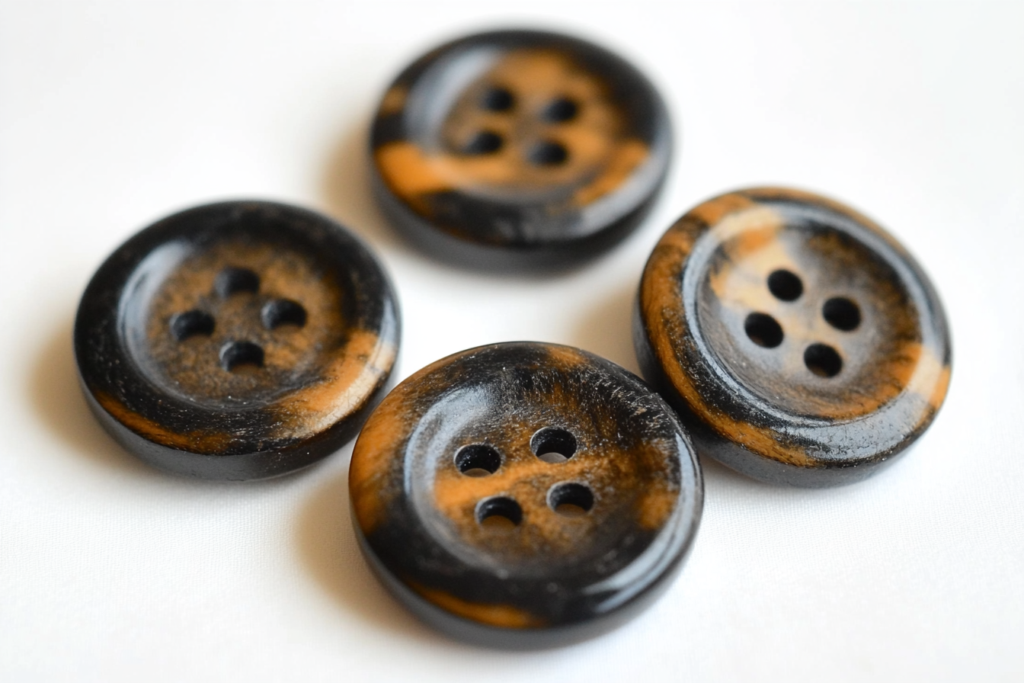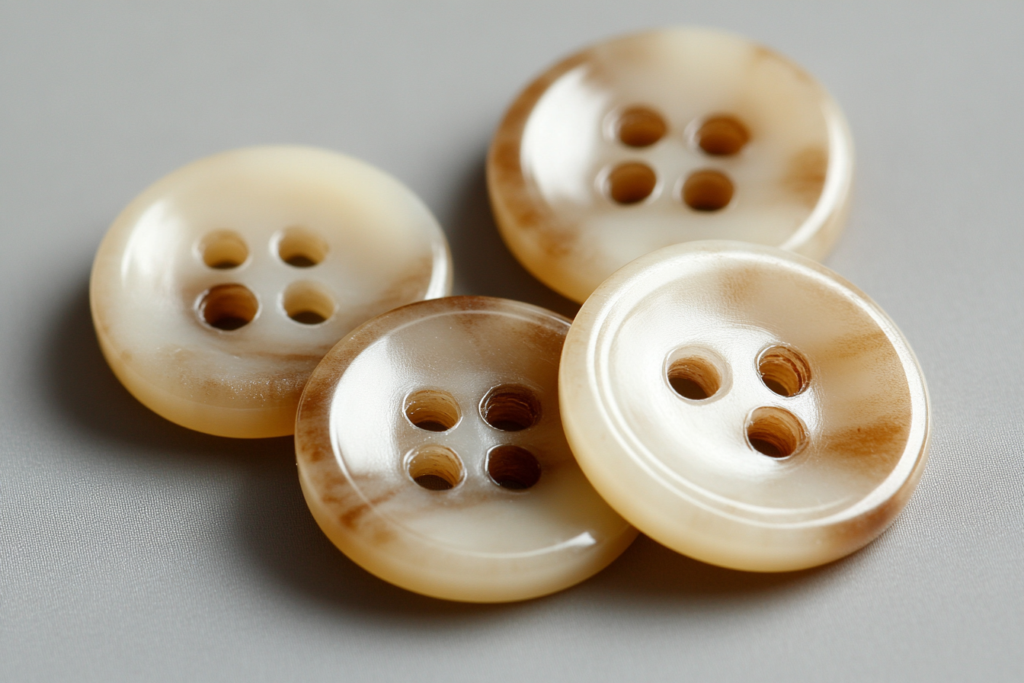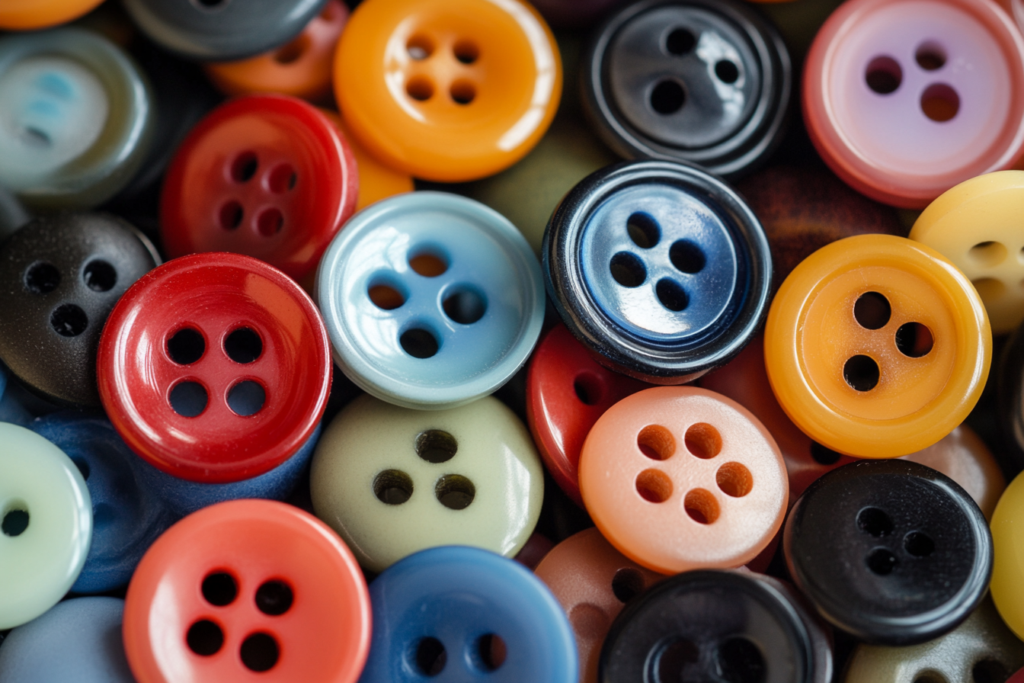Introduction: What Are Eyed Buttons?
Eyed buttons are the most commonly used type of button for fastening garments. They are characterized by small holes, called eyes, that are used to sew the button onto a piece of fabric. The two most common variations of eyed buttons are the two-hole button and the four-hole button. These buttons are an essential component in the fashion and textile industry, providing both functional and aesthetic benefits to various garments, including shirts, jackets, pants, and coats.
Unlike shank buttons, which feature a small protruding loop on the back, eyed buttons have holes for sewing through the fabric, offering a secure attachment. Their versatility, combined with their wide range of sizes, colors, and materials, makes them suitable for almost any type of garment.


Types of Eyed Buttons
- Two-Hole Buttons:
- As the name suggests, two-hole buttons feature two holes through which thread is sewn to attach the button to the garment. These buttons are typically used for lighter-weight fabrics and in applications where simplicity and minimal bulk are desired.
- Two-hole buttons are often seen in shirts, blouses, and dresses. Their streamlined design offers a clean, modern aesthetic that fits well with both casual and formal garments.
- Four-Hole Buttons:
- Four-hole buttons have an additional set of holes, allowing for a more secure attachment when sewn onto the fabric. These buttons are typically used for heavier fabrics, such as jackets, coats, and pants, where durability is crucial.
- The four-hole design provides added strength and can be sewn in multiple ways to create different looks. For instance, the thread can be crisscrossed or sewn in parallel rows, both of which enhance the button’s hold and the overall appearance of the garment.
- Specialty Eyed Buttons:
- Some eyed buttons come in unique shapes, such as heart-shaped, oval, or square, offering additional decorative appeal. These specialty buttons are often used in fashion-forward or designer garments where attention to detail and aesthetic appeal are essential.
Materials Used for Eyed Buttons
Eyed buttons are made from a wide range of materials to suit different types of garments and purposes:
- Plastic:
- Plastic buttons are the most common due to their affordability and versatility. They can be molded into various shapes and sizes, and their wide color range allows for endless design possibilities.
- Wood:
- Wooden buttons provide a rustic or vintage look and are commonly used in casual garments such as denim jackets, cardigans, and trousers.
- Metal:
- Metal buttons are durable and often used for outerwear, military uniforms, or formal attire. These buttons typically have a polished or brushed finish and are known for their strength and longevity.
- Shell:
- Shell buttons are often used in high-end fashion, as they offer a refined, elegant look. These buttons are typically seen in luxury shirts, coats, or blouses.
- Fabric-Covered:
- Fabric-covered buttons feature a soft textile surface, providing a smooth, uniform look that matches the garment’s fabric. These buttons are common in suits, dresses, and blouses.
How to Sew Eyed Buttons onto a Garment
Sewing an eyed button onto a garment is a simple process, but it requires careful attention to detail to ensure durability and proper alignment.
Step-by-Step Guide to Sewing a Two-Hole Button:
- Position the Button:
- Place the button in the desired position on the fabric, aligning the holes with the edges of the buttonhole.
- Thread the Needle:
- Choose a strong, matching thread and thread it through the needle. Tie a small knot at the end of the thread.
- Sew Through the Holes:
- Insert the needle through one hole of the button and pull it through until the knot catches. Then, bring the needle through the second hole, pulling the thread tight to secure the button.
- Repeat:
- Repeat this process several times, ensuring that the button is securely attached to the fabric.
- Tie the Knot:
- Once the button is firmly attached, tie a knot at the back to secure the thread.
Step-by-Step Guide to Sewing a Four-Hole Button:
- Position the Button:
- Position the button over the buttonhole with the four holes facing upward.
- Sew the First Set of Holes:
- Insert the needle through one hole and then across to the opposite hole. Pull the thread tight to secure the first side of the button.
- Sew the Second Set of Holes:
- Repeat the process with the other set of holes, ensuring the button is secured from all four directions.
- Strengthen the Attachment:
- After sewing through all four holes, pass the needle through the button multiple times to ensure a firm attachment. Tie a knot at the back to complete the process.
Benefits of Eyed Buttons
- Strong and Secure:
- The sewing method used for eyed buttons provides a secure hold on the garment, reducing the chances of the button becoming loose or detached.
- Variety of Styles:
- Eyed buttons come in various sizes, shapes, and materials, giving designers flexibility in choosing the right button for different garments.
- Versatility:
- Whether used for casual wear, workwear, or formal attire, eyed buttons are incredibly versatile and suitable for a wide range of clothing types.
- Durability:
- When sewn properly, eyed buttons can withstand wear and tear, making them ideal for everyday garments that require frequent use.



